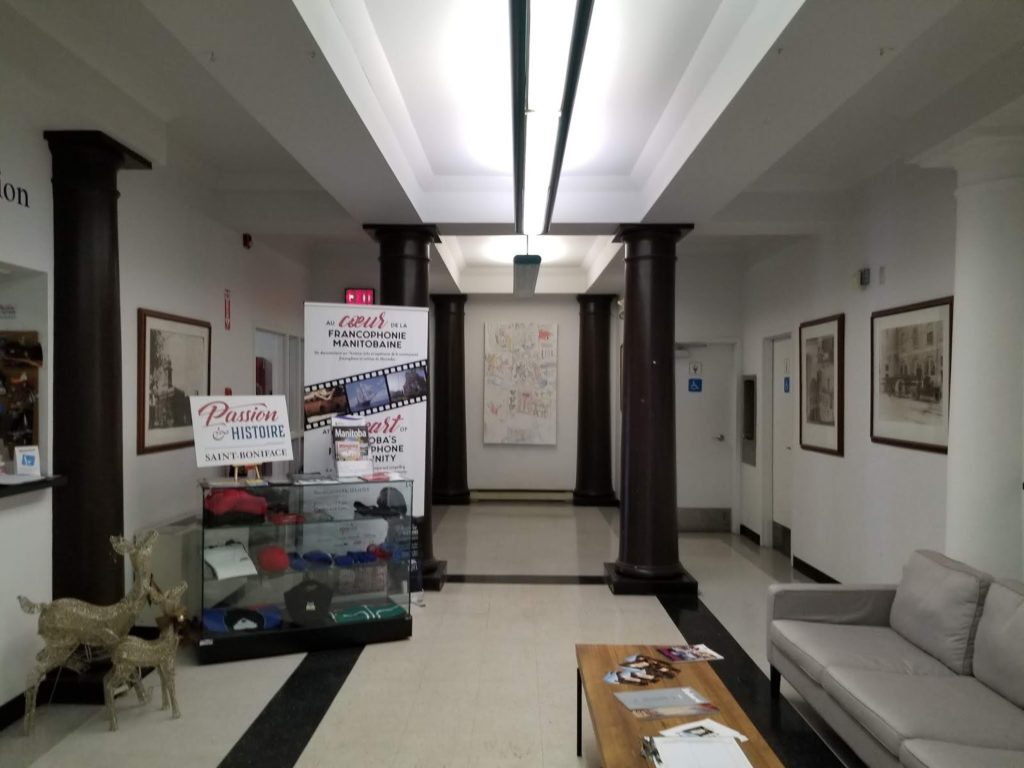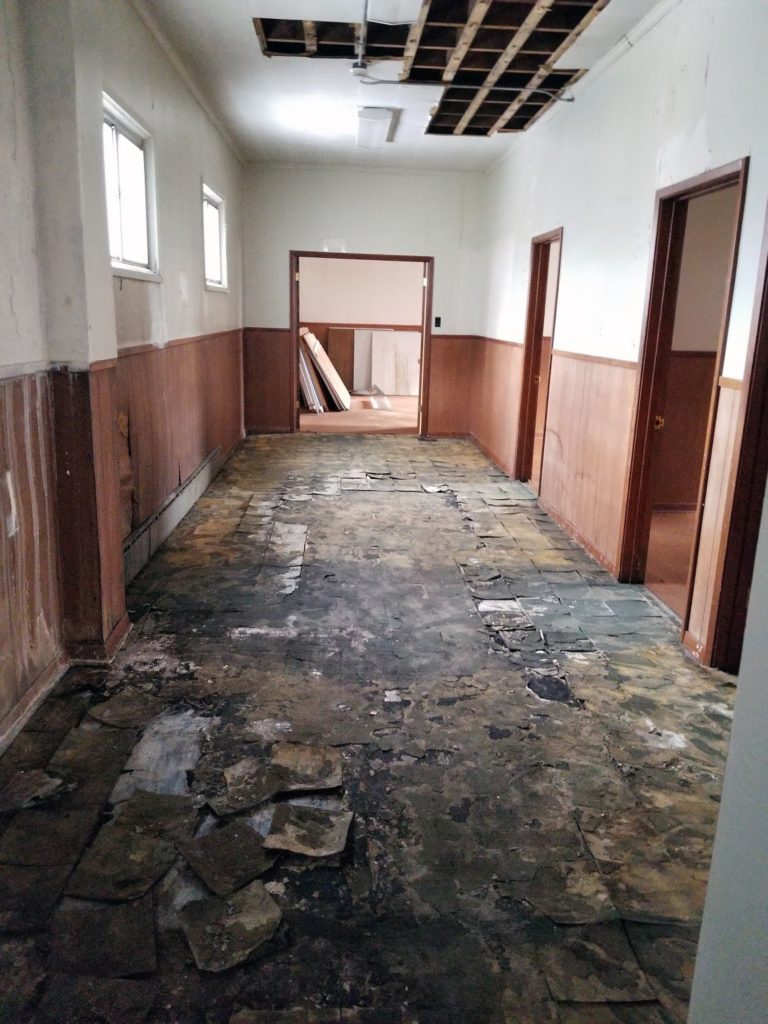
/ Blog
December 12, 2019
An Opportunity for Revival: The Sale of the St. Boniface City Hall and Fire Hall No. 1
On December 4, 2019, the St. Boniface City Hall and Fire Hall No. 1 saw dozens of people walk through their doors to attend their open houses. This took place just a week after the City of Winnipeg announced their plans to sell these two historic structures and put out a request for proposals. Local media picked up the story quickly, and it appeared in the Winnipeg Free Press, CTV Winnipeg, and CBC in short order. Though the deadline for proposals is not until February 2020, concerns about the existing tenants in city hall and prospective redevelopment of the fire hall have been swirling around the heritage community. Both buildings are designated municipal historic structures. The Fire Hall at 212 Dumoulin Street was designated on September 14th, 1987 and the City Hall at 219 Provencher Boulevard was designated November 2nd, 1981.
Though these two buildings are being lumped together in the city’s request for proposals, the City Hall and Fire Hall differ wildly in their previous uses and current states.
St. Boniface City Hall was completed in 1906. Based off a watercolour portrait done by architect Victor Horwood, it could fit everything the small city needed. City clerks, the mayor, and the chief of police all had offices inside the building. The basement also accommodated eleven jail cells at the time of construction.

Crowds in St. Boniface greet Governor General Bessborough at the St Boniface City Hall in 1932.
Source: Manitoba Provincial Archives
One of the buildings more striking features, the clock tower, was actually a later addition. Originally, atop the small building was a dome that Le Manitoban described as looking like a “Beehive” and was generally disliked. City Council paid to replace it with the current tower in 1908. Though the building is certainly classical inspired, it’s hard to pin it down to one particular style – an observation that was made by Le Manitoban during the construction of the aforementioned tower. The City of St. Boniface operated out of the structure until they amalgamated with the City of Winnipeg in 1972.

The first tower on the St. Boniface City Hall (left in 1907) was so loathed by the citizens that it was insisted that the architect, Victor William Horwood rebuild it to be closer to the original plans (new tower, right, in 1911).
Source: City of Winnipeg and the Archives of Manitoba
Extensive renovations in 1989 modernized the old City Hall which now fits the offices of Tourism Riel, the World Trade Center Winnipeg, and the gallery of La Maison des artistes visuels francophones (MDA). This renovation project means that the building is in excellent shape. Barring some drywall that needs to replacing, the repair work required is minimal. The upper two floor, home to the World Trade Center Winnipeg, looks more like modern office spaces than a former police chief’s headquarters. On the main Tourism Riel operates out of the main floor, promoting tourism initiatives and events (including Heritage Winnipeg’s Doors Open Winnipeg). The clock in the tower has been repaired, too. When it broke, initially, it caused something of a stir in the community as many relied on the clock to keep track of the time. Inarguably City Hall is an easier structure to sell. Recently renovated and with tenants already in the building it essentially appears move-in ready.

One of the renovated third floor office spaces in the City Hall.
Source: Sabrina Janke for Heritage Winnipeg

Looking out the window from the third floor landing of the City Hall.
Source: Sabrina Janke for Heritage Winnipeg

Tourism Riel’s banners and merchandise near their first floor office in the City Hall.
Source: Sabrina Janke for Heritage Winnipeg

The former council chambers in the St. Boniface City Hall have been turned into presentation for the World Trade Centre Winnipeg which now occupies the space.
Source: Sabrina Janke for Heritage Winnipeg
The old St. Boniface Fire Hall No. 1 is a different story. Largely empty since 2010, the years of disuse are evident. Paint peels off the pressed tin, water damage is visible on the floors and ceiling, and holes line the walls. Overall heating of the structure has ceased and small space heaters did their best against the December chill during the open house. Still – this is not an insurmountable problem. Costly yes, but demolition worthy no. Great potential still exists in the building and structurally the it is fine.

Water damage is visible on the flooring on the second floor of the Fire Hall.
Source: Sabrina Janke for Heritage Winnipeg
More than this though, the Fire Hall is an important part of the history of Winnipeg’s Francophone community. Built like a medieval fortress, it defied the standard architectural style used for fire halls at the turn of the twentieth century. When it opened in 1907, around the same time St. Boniface was incorporated as a city, most fire halls were built using the “Melville Design” as a guideline. Also designed by Victor Horwood, both the Fire Hall and City Hall are built in a similar classical style. The community must have liked Horwood’s work, as he had also designed the St. Boniface Fire Hall No. 2.

A closer view of the front elevation of the Fire Hall, with the station’s name and number above the large garage doors.
Source: Sabrina Janke for Heritage Winnipeg
Horwood added two towers to Fire Hall No. 1, unlike the one tower seen in traditional Melville designs. One tower was meant to be used for drying hoses, and the other to operate as a bell tower. Both feature crenelations along the top, resembling medieval watchtowers. Renovations were undertaken as firefighting technology changed. Horse stables were replaced with garages for new fire trucks, and new dormers were added along the roof to add additional light. Sometime in the 1970s, the space was changed from a fire hall into a fire-fighting museum and storage space. Though by 2010 the building was considered “non-essential” and used exclusively for storage space.

Artefacts from the former museum still sit in their glass cases in the Fire Hall.
Source: Sabrina Janke for Heritage Winnipeg

Paint peels off the pressed tin, and the old fire pole still remains on the first floor of the Fire Hall.
Source: Sabrina Janke for Heritage Winnipeg

The original spiral staircase connection the floors of the Fire Hall.
Source: Sabrina Janke for Heritage Winnipeg

Furniture still remains in the upper levels of the Fire Hall.
Source: Sabrina Janke for Heritage Winnipeg
Both buildings, the St. Boniface City Hall and Fire Hall No. 1, are designated historic structures with varying degrees of protection. In the case of City Hall, the exterior, stairwell, tower, and the entire first and second floor are protected. With the Fire Hall, it is only the exterior and the pressed tin walls and ceiling on the inside that must be maintained. While this makes gutting the building an impossibility, it is not the largest hurdle for developers to leap. The pressed tin in the fire hall is indeed unique to the building (pressed tin is rarely used on walls) – and keeping it will make future spaces stand out.

Pressed tin detailing on the ceiling of the Fire Hall. This is considered a character defining element (a CDE) of the building and must be protected.
Source: Sabrina Janke for Heritage Winnipeg
In the request for proposals the City of Winnipeg mentions a number of planning strategies to keep in mind as developers draft up their plans. Simply constructing high end condos is not an option here. Pulling from Our Winnipeg, The North St Boniface Plan Secondary Plan & Provencher Boulevard Development Overlay, the ideal proposal would reimagine these structures as mixed-use facilities that promotes pedestrian traffic on Provencher Boulevard and would ideally be open to the public in some capacity.
A creative developer who appreciates the value of built heritage who has the right resources could reimagine these spaces as any number of things. After all, St. Boniface is not the first place to have a fire hall or a city hall redeveloped. An old fire hall in Old Montreal was renovated into a local history center, while a historic fire hall in Vancouver was modernized while retaining its original elements. Even in Winnipeg, Crescentwood’s Fire Hall No. 12 was renovated into condominiums in 1982 and both Maple Street’s Fire Hall No. 2 and St. Vital’s Fire Hall are now museums.. In Toronto, proposals have come forward to turn their former city hall into a municipal museum.

The third floor of the Fire Hall features closets that would have been used to store fire fighters equipment. The window is one of the additional dormers added in 1908 to add natural light to what was otherwise a fairly dark space.
Source: Sabrina Janke for Heritage Winnipeg
The point of these examples being, quite simply, that a successful redevelopment is entirely possible. It is also entirely necessary. Keeping purpose built structures frozen in time is not a solution. We must find adaptive ways to reuse the structures to keep them occupied, viable, and protected. Adaptive reuse is also the most environmentally sustainable option, as it generates significantly less new waste than a demolition would and maintains the building’s embodied energy. In keeping these buildings, we also preserve an integral part of Manitoba’s francophone history.
The deadline for proposals is February 20th, 2020. Whatever comes out of the redevelopment of the St. Boniface City Hall and Fire Hall No. 1 has a chance not just of revitalizing beautiful heritage structures, but also of creating something wholly unique to our city.
THANK YOU TO THE SPONSOR OF THIS BLOG POST:

Written by Heritage Winnipeg.
SOURCES:
CBC | City puts historic St. Boniface city hall up for sale
City of Winnipeg Historic Resources: 219 Provencher
City of Winnipeg Historic Resources: 212 Dumoulin
City of Winnipeg Request for Proposals RFP NO. 982-2019
CTV News | City seeking buyer for old St. Boniface City Hall, fire hall
Heritage Winnipeg Files
SHDM | In a fire station repurposed into a centre for history, Montréal’s heritage is taking root
The Star | Old City Hall set to become home to a museum of Toronto
Vancouver Heritage Foundation: Fire Hall N. 15
Winnipeg Free Press | Heritage buildings in St. Boniface up for sale















